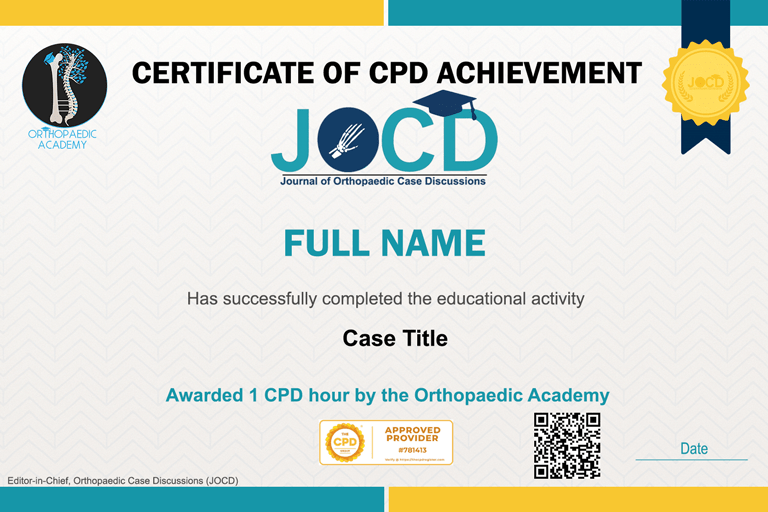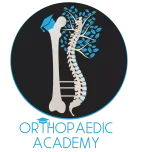A Challenging Lower Limb Pain Presentation – When Symptoms Don’t Match the X-ray
Case Details
Relevant Clinical History
A 53-year-old female was referred by her GP for consideration of total knee replacement, presenting with right knee pain causing significant difficulty with walking, sleep, and activities of daily living, particularly those involving bending or dressing. She reported no history of trauma or previous knee surgery.
Figures



Self-Test Questions
How would you assess and examine this patient?
Suggested Answer & Explanation:
Begin by taking a thorough history and listening carefully to the patient, as important diagnostic clues often emerge from their description of symptoms and functional limitations. Review the GP or primary care referral letter, which may highlight relevant background information or early clinical findings.
Knee Examination:
Inspection and assessment revealed no abnormality. There was no effusion, the skin colour was normal, and there were no scars.
-
Straight Leg Raise: Normal
-
Range of Motion: Full and pain-free
-
Stability tests: Normal valgus/varus stability
-
Patellofemoral joint: No crepitus, tenderness, or apprehension
-
Ligamentous tests: Lachman’s, anterior/posterior drawer, and McMurray’s tests were all normal
Hip Examination:
Both hips were markedly stiff and tender, with reduced range of motion and evidence of fixed flexion deformity. Thomas test was positive, indicating loss of hip extension.
Examination of Adjacent Regions:
Assessment of the lumbar spine and ankles was normal.
What are your differential diagnoses for this presentation?
Suggested Answer & Explanation:
-
Inflammatory arthropathy, including synovitis without radiographic evidence of knee joint degeneration
-
Soft-tissue injury or degenerative pathology, such as meniscal tears or other periarticular disorders
-
Soft-tissue tumour around the knee region
-
Lumbar spine pathology, including spondylosis or spinal stenosis causing referred pain
-
Insufficiency or stress fractures
-
Avascular necrosis (AVN) of the hips
-
Spontaneous osteonecrosis of the knee (SONK)
-
Hip osteoarthritis presenting as referred knee pain
What further investigations would you consider for this patient?
Suggested Answer & Explanation:
-
AP pelvic X-ray and lateral views of both hips to assess for hip osteoarthritis, avascular necrosis, or other proximal pathology
-
Additional knee views, including Skyline (patellofemoral) and Rosenberg (PA) views, if knee pathology remains a concern
-
MRI of the knee, femur, or tibia to evaluate soft-tissue injury, occult fractures, or marrow pathology when clinically indicated
-
MRI of the lumbar spine or pelvis as a later step, particularly when symptoms suggest referred pain or lumbosacral plexus involvement
-
General blood tests, including screening for inflammatory arthropathy (e.g., ESR, CRP, rheumatoid markers)
How would you manage this patient?
Suggested Answer & Explanation:
Conservative Options (Initial Considerations):
Although this patient may trial standard non-operative measures, including:
-
Analgesia and pain-relief optimisation
-
Physiotherapy and targeted exercises
-
Image-guided intra-articular injections (e.g., corticosteroid)
her presentation is too advanced for conservative management alone, given the severity of symptoms and significant functional impairment.
Definitive Management:
The patient requires bilateral sequential Total Hip Replacements (THR) as the most appropriate and effective treatment to address her pain, stiffness, and loss of function.
Pre-operative Discussion and Planning:
-
Discuss the type of hip replacement and implant options, as well as any potential alternatives (e.g., hip resurfacing, if suitable).
-
Provide full counselling and informed consent, covering the risks, benefits, potential complications, expected recovery pathway, and realistic functional outcomes.
-
Optimise the patient medically prior to surgery and plan staged procedures according to priority and functional limitation.
Outcome and Case Discussion
Initial management options for this patient included standard conservative measures such as analgesia optimisation, physiotherapy, exercise therapy, and image-guided injections. While these interventions may provide temporary relief in earlier stages of disease, the patient’s presentation was too advanced for non-operative management, given her severe pain, marked functional limitation, and significantly restricted hip motion.
Radiological assessment confirmed advanced bilateral hip pathology, explaining the disproportionate knee pain and normal knee examination findings. Her symptoms were therefore most appropriately managed with bilateral sequential Total Hip Replacements (THR). This approach offers the greatest likelihood of restoring mobility, improving quality of life, and alleviating referred knee pain originating from the hips.
This case highlights the importance of maintaining diagnostic breadth when assessing knee pain, ensuring that hip pathology is considered—particularly when knee findings are normal. It also reinforces the need for timely orthopaedic intervention when conservative measures are unlikely to provide meaningful benefit.
Summary of Learning Points
-
Maintain a high index of suspicion when symptoms are severe or atypical.
-
Always consider alternative causes of pain, particularly when clinical findings do not match the initial diagnosis.
-
Think beyond the obvious when the severity of pain is disproportionate to knee X-ray findings.
-
Remember that common conditions occur commonly — hip osteoarthritis remains a frequent cause of referred knee pain.
-
Obtain a pelvic X-ray in any patient presenting with knee pain, especially when the knee examination is normal.
-
Avoid assumptions and pre-conceived diagnoses; base decisions on objective assessment rather than referral expectations.
-
Listen carefully to the patient, including any information they have been given previously (e.g., being told they require a TKR).
-
Seek a second opinion or involve an MDT when diagnostic uncertainty persists.
References
Abdulkareem I H et al, Exploring Other Causes of Hip Pain Beyond Osteoarthritis in Adults: A Narrative Review and Case Series, Ann Med Clin Cas Rept, 2025; 1(2): 1-31.
Murphy LB, Helmick CG, Schwartz TA, Renner JB, Tudor G, Koch GG, et al. One in four people may develop symptomatic hip osteoarthritis in his or her lifetime. Osteoarthritis and Cartilage. 2010;18(11):1372-9.
Swain S, Sarmanova A, Mallen C, Kuo CF, Coupland C, Doherty M, et al. Trends in incidence and prevalence of osteoarthritis in the United Kingdom: findings from the Clinical Practice Research Datalink (CPRD). Osteoarthritis Cartilage. 2020;28(6):792-801.
Salman LA, Ahmed G, Dakin SG, Kendrick B, Price A. Osteoarthritis: a narrative review of molecular approaches to disease management. Arthritis Research & Therapy. 2023;25(1).
Loeser RF, Goldring SR, Scanzello CR, Goldring MB. Osteoarthritis: A disease of the joint as an organ. Arthritis & Rheumatism. 2012;64(6):1697-707.
Katz JN, Arant KR, Loeser RF. Diagnosis and Treatment of Hip and Knee Osteoarthritis. JAMA. 2021;325(6):568.



Many thanks